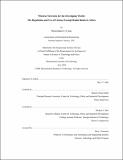| dc.contributor.advisor | Sharon Eisner Gillett and Michael L. Best. | en_US |
| dc.contributor.author | Neto, Maria Isabel A. S., 1974- | en_US |
| dc.contributor.other | Massachusetts Institute of Technology. Technology and Policy Program. | en_US |
| dc.date.accessioned | 2005-05-17T14:52:17Z | |
| dc.date.available | 2005-05-17T14:52:17Z | |
| dc.date.copyright | 2004 | en_US |
| dc.date.issued | 2004 | en_US |
| dc.identifier.uri | http://hdl.handle.net/1721.1/16670 | |
| dc.description | Thesis (S.M.)--Massachusetts Institute of Technology, Engineering Systems Division, Technology and Policy Program, 2004. | en_US |
| dc.description | Includes bibliographical references (p. 216-226). | en_US |
| dc.description | This electronic version was submitted by the student author. The certified thesis is available in the Institute Archives and Special Collections. | en_US |
| dc.description.abstract | As radio technologies and public policies evolve, an increasing amount of spectrum is being set aside for transmission use without a license. These license-exempt, or "unlicensed" bands, include 2.4 GHz and 5 GHz in the USA and much of Europe. I argue that this unlicensed spectrum, and low-cost wireless technologies that operate in these bands, is of particular value in the developing world, where it has the potential to substantially impact accessibility and availability of information and telecommunication services. In the context of numerous institutional and structural obstacles to entry license-exempt regulation potentially provides a friendly environment for entrepreneurship, reducing barriers to entry and the risk of regulatory capture. In order to assess this opportunity in the context of Africa, I have surveyed every country in the continent on their regulations and use of the 2.4 and 5 GHz bands. Responses, from differing country informants though mostly from the regulators themselves, were received from 47 of the 54 countries of Africa, which accounts for 95% of the continent's population. The responses show that there is significant diversity and heterogeneity in the regulation of these bands across Africa. Not only do licensing requirements and specific conditions change widely from country to country, but so do power, range and services restrictions, as well as certification requirements. In addition, regulation is still not in place in some countries, and is changing in others. Enforcement is low, adding to overall uncertainty. Lack of clarity in regulation and enforcement creates confusion and may discourage smaller players from entering the market. For bigger players interested in taking advantage of economies of scale | en_US |
| dc.description.abstract | (cont.) and implementing common strategies across borders, the heterogeneous regulatory environment will also act as a deterrent and a barrier to entry. Despite this heterogeneity, these bands are being used in most African countries, not only for "hotspot" style or other localized coverage in urban areas, but also for longer area coverage. A significant 37% of the countries that responded are using wireless technologies operating in these bands for providing backhaul network connectivity in rural areas. In unlicensed bands regulation tends to place a burden on the transmitter though, e.g. through power restrictions, in particular where competition in the market is low. In view of the continent's weak teledensity and lack of alternative infrastructure, establishing a more certain and uniform regulatory framework and promoting an appropriate business climate across Africa may be instrumental in encouraging private investment and connectivity through technology in these bands. The TU may have a key role to play, both by issuing clearer guidelines for the regulation of license-exempt bands, and by serving as a convening forum for countries to establish common regulatory strategies. While a fair balance is needed in regulation, this thesis argues that governments should err on the side of laxity in order to lower barriers to entry and counterbalance current overregulation of these bands. | en_US |
| dc.description.statementofresponsibility | by Maria Isabel A.S. Neto. | en_US |
| dc.format.extent | 226 p. | en_US |
| dc.format.extent | 1455454 bytes | |
| dc.format.extent | 1622641 bytes | |
| dc.format.mimetype | application/pdf | |
| dc.format.mimetype | application/pdf | |
| dc.language.iso | eng | en_US |
| dc.publisher | Massachusetts Institute of Technology | en_US |
| dc.rights | M.I.T. theses are protected by copyright. They may be viewed from this source for any purpose, but reproduction or distribution in any format is prohibited without written permission. See provided URL for inquiries about permission. | en_US |
| dc.rights.uri | http://dspace.mit.edu/handle/1721.1/7582 | |
| dc.subject | Technology and Policy Program. | en_US |
| dc.title | Wireless networks for the developing world | en_US |
| dc.type | Thesis | en_US |
| dc.description.degree | S.M. | en_US |
| dc.contributor.department | Massachusetts Institute of Technology. Engineering Systems Division | |
| dc.contributor.department | Technology and Policy Program | |
| dc.identifier.oclc | 56749204 | en_US |
